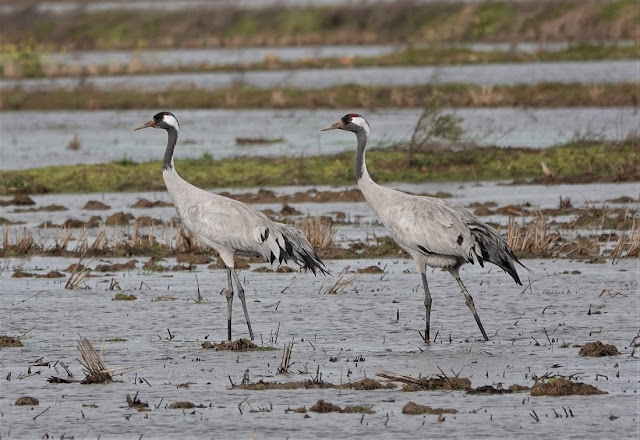Counting time
 |
| Common Cranes (Martin Kelsey) |
Returning to Extremadura after caring for my mother during her final weeks is like turning a page and starting a new chapter. With the passing of one's parents, life is never again the same. A reminder of mortality, but also the urge to commit to never taking things for granted, to appreciate what we have around us. Let nature flow!
January here is counting time. Counting birds that is, and most of my time in the last few days has been about doing that. So here is my counting tale, which ends with an owl and a duck!
On my return, what better than to take the walk from home, taking in the hill behind the house in circular route along a lane, amongst old olive groves, pasture and patches of evergreen oak dehesa? This is a favourite of mine and one which I use to contribute every winter to the bird population monitoring work of SEO/BirdLife. During two hours I record every individual bird. I have done so twice for each of the last eleven winters. Overall on 21 walks (I still have one walk left to do this winter) I have recorded 62 species of birds and counted 14,564 individual birds. On my count last week was 34 species and 598 individuals, the commonest five being Chaffinch, Song Thrush, Spanish Sparrow, Spotless Starling and House Sparrow. Interestingly, Blackcaps, which normally are somewhere in the top three (and I have recorded 2147 individuals to date) were fewer than usual. They feed mainly on olives and it had been a very poor winter for the fruit.
 |
| Alcollarín Reservoir (Martin Kelsey) |
The COVID-19 restrictions continue in Extremadura. Currently we have to remain within our local municipal boundaries. However, an exception has been granted this month for long-term wildlife monitoring work. Thus, bearing my official safe passes, signed by the government of Extremadura, I have been able to participate in the census of Common Cranes, and the international wetland birds survey. My local patch, the reservoir of Alcollarín (which come the expiry date of my survey permit, will be out of bounds for me as it lies in another municipality), was one of the sites I counted. There rafts of duck floated somnabulantly, gently rocking on the wavelets. The count took me most of the day, partly because of the simple scale of the task, but also because I sought to prolong the reconnection with nature there for as long as I possibly could. During the six hours of my stay, I met no one. Only a distant shepherd was out and, as I left, a walker from the nearby village. But whilst hardly any people, there were nearly 11,500 birds, with Shoveler dominating with 6650 present. I have yet to see the overall results from Extremadura, but I suspect that this flock will be largest of the region.
 |
| Wet winter rice fields Martin Kelsey) |
A few days later I slowly tracked the perimeters of expanses of arable land to count wintering Common Cranes. The generous rains this winter have left the rice-fields far soggier than usual. More of the stubble had been ploughed into the mud and most fields were now inundated. The view across my census zones was quite different from the usual - a vast body of open water. The cranes had largely concentrated on the few areas unploughed and on the fields of maize stubble. My total at the end of the day was 7,121 birds.
 |
| Short-eared Owl (Martin Kelsey) |
On completion of the count, I followed a track across the fields themselves, as the quickest way back home. The flooded fields were largely devoid of much birdlife, apart from the Black-headed Gulls which swiveled in dainty fashion as they swam, their neck at a hauty angle, their wing-tips raised in a fastiduous gesture to keep them dry. As I watched, a bouyant silent smoothness appeared, moved more by the gusts of wind than by its own effort, it seemed. Landing on a bank, its quince-yellow eyes fixed on me, before its head turned, with the padding of a feather duvet. The Short-eared Owl rose again, carried by the breeze in my direction, coming aground right beside the car, which it glowered at through a picket of dry plant stems.
 |
| Short-eared Owl right beside the car (Martin Kelsey) |
I paused once more at Alcollarín. The afternoon was overcast, but it had stayed dry. If anything there seemed be even more Shoveler there than during my count, evenly spread across the main body of water. I set up my telescope and careful worked my way through the dozing duck, on the look out for something different. I have done so countless times and once in a while I am rewarded by a surprise. Over time, I have seen almost all the duck species recorded in Extremadura at this site. But for many years I had vainly searched the groups of Common Teal for the North American subspecies, carolinensis (the "Green-winged Teal"). Teal are second only to Shoveler in terms of abundance here. My count yielded a staggering 1890 birds. So it was with a wee bit of hope but very low expectations that I focused on these smaller duck. Clearly though my planets were in alignment that day, because after barely ten minutes of routine scanning, a dot of a Teal came into the field of my telescope. Despite being half a mile away, the striking white vertical band bordering its breast was clearly visible, almost like a slit, so clean cut it appeared. I only managed the poorest of record photos using my mobile phone, but this diagnostic feature was easy to see. Let nature flow indeed!
 |
| A very distant Green-winged Teal (Martin Kelsey) |



Comments